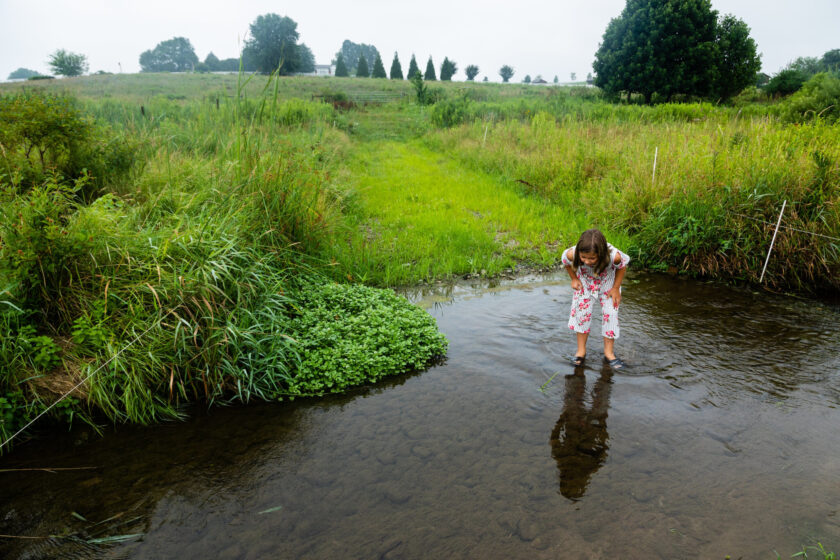Matthew Kirchner
Lancaster, Pennsylvania
When Matthew Kirchner and his wife, Megan, bought their 83-acre property in Lancaster, Pennsylvania in 2011, they could hardly imagine the major changes to their land that were in store. Part of the property consisted of Big Spring Run, a degraded wetland-stream complex that was scheduled to undergo a novel restoration. Matthew bought the property at auction in the spring of 2011 with the restoration scheduled to begin the following fall. Aware of the restoration but having little knowledge of the details, he gave his permission for the project to continue.
The former landowner, Joseph Sweeney, played a major role in the development and design of the Big Spring Run restoration. Unsatisfied with traditional restoration methods that failed to fix the erosion along the stream bank, he set out to try something new. He worked with professors from Franklin and Marshall College who had been conducting research on his property about the effect of historical mill dams on aquatic ecosystems throughout Pennsylvania. They found that the numerous dams that were created to power mills in the 19th century had caused unrecognized and unanticipated changes to valley bottom hydrology and ecology. Over time, thick layers of sediment eroded from upstream sources and settled across the valley bottom, creating a layer of “legacy sediment.” Today, these sediments are especially vulnerable to erosion. However, researchers also found evidence of original wetland landscapes preserved underneath the legacy sediment – dark wetland soils filled with wetland plant seeds and other organic matter.
Big Spring Run became a pilot project for the removal of legacy sediment and restoration of the original wetland landscape. The project had several partners but was primarily sponsored by the Pennsylvania Department of Environmental Protection and funded through the Growing Greener Program. Over four months, 4.5 acres of wetlands were restored in the valley bottom, cattle crossing and protective fencing were installed, and a riparian buffer was implemented.
Despite coming into the project with very little knowledge and several concerns, Matthew became involved by attending planning meetings and stepping aside when necessary, trusting the professionals to do the right thing. The site is now in its ninth growing season since the restoration was completed, and Matthew and his family have experienced the benefits for themselves. “I see the established vegetation, I see the habitat that it creates for wildlife…every time we go over there we see different things,” he said. On walks with his children over the past few years, they have seen rare salamander species, coyotes, nesting ducks and geese, deer, muskrats, wading birds, foxes and raccoons.
The Kirchners rent out the farm to a tenant farmer that is responsible for planting and harvesting, striking a balance between the agricultural portion of his land and the newly restored Big Spring Run that brings a lot of value for the family’s enjoyment.
“We were overwhelmed with everything in the beginning, but we put a lot of trust in the [professionals]…they’ve been very respectful of our land, they were great to work with, and if we had to do it over we would do it again.”
- Matthew Kirchner
Joseph Sweeney has been equally thrilled by the results of this project. He acknowledged, “It may seem like a very disrupting, daunting approach to environmental restoration, but the results are incomparable," citing the creation of habitat and pollinator opportunities, the reduction of water temperature from 15 to 7 degrees Celsius, and huge reductions of nitrogen, phosphorous and sediment.
Being the first successful example of legacy sediment removal, Big Spring Run continues to be studied by academic researchers and governmental institutions. The success of this project has paved the way for similar projects to follow. As Executive Director and founder of the Water Science Institute, Joe has delved into research on the landowner incentives and cost-benefit analyses for legacy sediment removal restoration as compared to typical restoration processes such as riparian or grass buffers or cover crops. Soon, he hopes to see more funding directed toward legacy sediment removal projects and a set of guidelines and recommendations for landowners who want to complete this type of restoration on their property.
Interested in wetland restoration on your land? Connect with a wetland planner near you.

